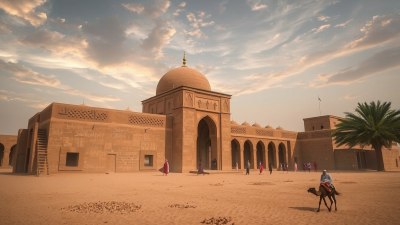Whispers of Empire in Djenne, Mali
Explore the rich history and cultural significance of Djenne, Mali, through its architectural marvels and vibrant heritage.

Image created with Flux Schnell
Djenne, Mali, is a city steeped in the echoes of history, a place where the grandeur of empires once ruled and the whispers of traders filled the air. Renowned for its mud-brick architecture, particularly the Great Mosque of Djenne, the city is a UNESCO World Heritage site that offers insights into the past grandeur of African civilizations. Founded over a millennium ago, Djenne rose to prominence as a center of trade, education, and culture, attracting scholars and merchants from various regions, including Europe and Asia. The city’s strategic location along the Niger River made it an essential hub for the trans-Saharan trade routes, facilitating the exchange of gold, salt, and knowledge.
The heart of Djenne's historical significance lies in its architectural marvels. The Great Mosque, built in the 13th century and reconstructed in 1907, is one of the largest mud-brick structures in the world and an excellent representation of Sudano-Sahelian architecture. Its enormous wooden pillars and intricate adobe work showcase the craftsmanship and ingenuity of the local artisans. Every year, the citizens of Djenne come together to replaster the mosque with mud in a community effort, a tradition that continues to strengthen their cultural identity and connection to their ancestors.
The Rise of Djenne as a Trade Center
In the 11th century, Djenne emerged as a leading center of trade under the influence of the Mali Empire, which flourished in the region. The empire was known for its wealth, power, and promotion of Islam, which played a significant role in the city's development. Djenne became a vital junction for traders who brought goods such as gold, textiles, and salt. This exchange not only enriched the local economy but also made the city a melting pot of cultures, languages, and religions.
The marketplace of Djenne is still bustling today, reminiscent of its past glory. Vendors sell handmade crafts, traditional fabrics, and aromatic spices, drawing visitors eager to experience the vibrant atmosphere. The market serves as a microcosm of the city’s historical role in global trade, allowing modern explorers to gain a sense of the lively interactions that shaped Djenne's identity.
Cultural and Religious Significance
Djenne's significance is not only economic but also cultural and religious. The city is an important center for Islam in West Africa, housing numerous mosques and Quranic schools that attract students and scholars from around the region. The Great Mosque, besides being an architectural wonder, is a vital center for religious activities, prayers, and community gatherings. It is a living testament to the heritage and enduring influence of Islam in Mali.
The surrounding landscape is dotted with traditional mud-built houses, with their distinctive architecture featuring intricately carved doors and windows. These structures reflect the adaptation of the local population to their environment, using available materials to create homes that withstand the harsh climate. The annual Festival of the Sahara, celebrating Djenne's cultural heritage, highlights the importance of these traditions in maintaining the city’s identity amidst modern challenges.
Historical Context and Colonial Impact
The history of Djenne cannot be discussed without acknowledging the impact of colonialism. In the late 19th century, French colonial powers sought to control the rich resources and trade routes of Mali, including Djenne. The city experienced significant transformations and challenges during this period, as the French imposed new agricultural practices and altered existing social structures. The imposition of colonial rule disrupted local economies and led to resistance from the people of Djenne, who fought to preserve their autonomy.
Despite these challenges, the cultural resilience of Djenne's people allowed them to maintain their traditions and support each other through community efforts. The legacy of the empire and the attempts to suppress such cultural expressions added complexity to Djenne's identity, leading to a rich tapestry of influences that can still be seen today.
The Modern Era and Preservation Efforts
Today, Djenne faces both opportunities and challenges. While it remains a vital cultural center, the city’s ancient structures require constant maintenance to withstand the elements. Organizations, both local and international, work tirelessly to promote conservation and sustainable tourism practices. These efforts aim to ensure that future generations can experience the incredible history of Djenne, as well as celebrate its unique culture.
The role of Djenne as a site of historical significance has gained renewed attention in recent years, attracting scholars and tourists interested in exploring its rich past. However, this interest also brings challenges, such as the need to balance preservation with the demands of tourism. Ensuring that the community benefits from these interactions is paramount, allowing locals to engage with visitors meaningfully while celebrating their heritage.
The Legacy of Djenne’s Empires
As a site that witnessed the rise and fall of empires, Djenne carries a legacy that transcends its geographical boundaries. The histories embedded in its architecture, stories, and communal practices continue to inspire future generations. The echoes of Djenne’s past remind us of the power of resilience and the importance of cultural preservation in a rapidly changing world. Ultimately, Djenne serves not only as a reminder of a rich historical tapestry but also as a beacon of hope for cultural identity amidst globalization.
As Djenne continues to thrive, the whispers of its empire remind us all of the significance of heritage in the face of modernity. The city embodies the ideal that cultural history is not confined to the pages of books but is alive in the very streets, buildings, and hearts of its people. A visit to Djenne is not merely a trip back in time; it is an invitation to connect with history, explore the complexities of cultural identity, and understand the importance of preserving the stories that shape our world.











